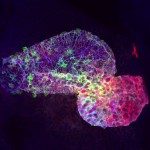Link to Pubmed [PMID] – 29279402
Proc. Natl. Acad. Sci. U.S.A. 2018 01;115(2):E283-E291
Colonization by subsp. (SGG) is strongly associated with the occurrence of colorectal cancer (CRC). However, the factors leading to its successful colonization are unknown, and whether SGG influences the oncogenic process or benefits from the tumor-prone environment to prevail remains an open question. Here, we elucidate crucial steps that explain how CRC favors SGG colonization. By using mice genetically prone to CRC, we show that SGG colonization is 1,000-fold higher in tumor-bearing mice than in normal mice. This selective advantage occurs at the expense of resident intestinal enterococci. An SGG-specific locus encoding a bacteriocin (“gallocin”) is shown to kill enterococci in vitro. Importantly, bile acids strongly enhance this bacteriocin activity in vivo, leading to greater SGG colonization. Constitutive activation of the Wnt pathway, one of the earliest signaling alterations in CRC, and the decreased expression of the bile acid apical transporter gene , as an effect of the founding mutation, may thereby sustain intestinal colonization by SGG. We conclude that CRC-specific conditions promote SGG colonization of the gut by replacing commensal enterococci in their niche.











